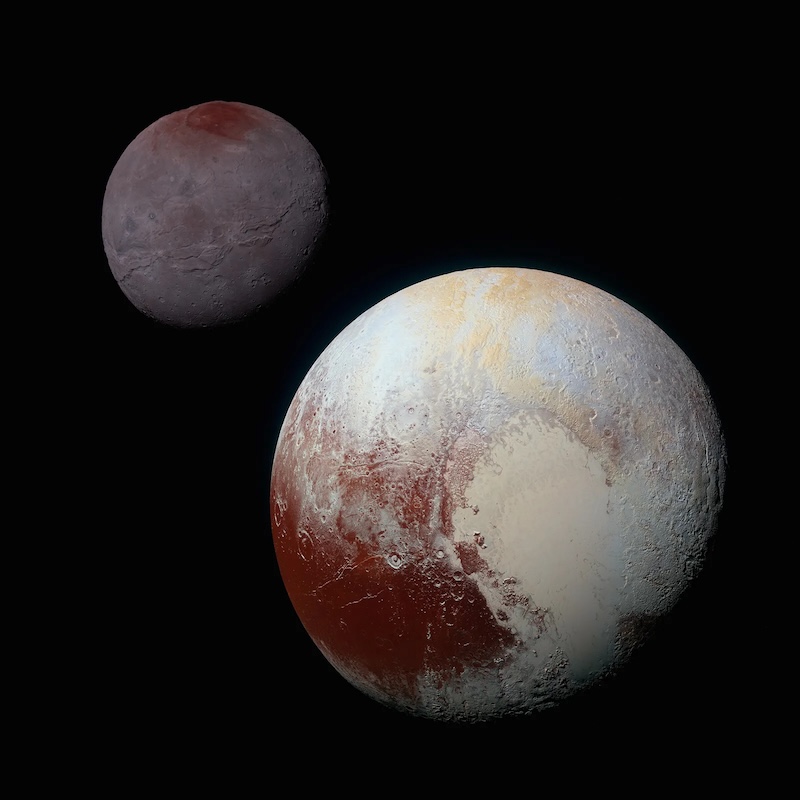Eris is the 2nd-largest of the dwarf planets. It’s slightly smaller than Pluto. Both are rocky worlds located far from our sun, in the deep freeze of the outer solar system … in the Kuiper Belt out past Neptune. So you might assume the two little worlds are similar, both inside and on the surface. And there are outer similarities. But researchers at the University of California Santa Cruz said on November 15, 2023, that Eris and Pluto are likely quite different at their cores. Despite their similarities, the cores of the two worlds might suggest different evolutionary paths.
Interestingly, the clues to the differences at their hearts come from the moons of each world. Dysnomia is the only known moon for Eris. Charon is the largest of Pluto’s five known moons. Both moons orbit synchronously with their dwarf planets. The researchers said the interiors of Eris and Pluto would need to be different, in order for those synchronous orbits to occur.
The researchers published their peer-reviewed findings in Science Advances on November 15.
The 2024 lunar calendars are here! Best Christmas gifts in the universe! Check ’em out here.
Tidally-locked dwarf planets and moons
You know how the gravity of Earth’s moon helps create tides in our oceans?
And perhaps you know that the Earth and moon are tidally locked. In other words, Earth’s gravity keeps a single face of the moon always turned in our direction.
Both Pluto and Charon – and probably also Eris and Dysnomia – are mutually tidally locked. In other words, we know for sure that Pluto and Charon keep a single face toward each other. And Eris and Dysnomia probably do, too.
If this is true, the researchers said, the both dwarf planets must have de-spun – slowed their rotation – in order to become synchronized with their moons.
But there’s a difference between these moon-and-dwarf-planet systems. Eris is much more massive than Dysnomia, while Pluto and Charon are closer in mass. So how did Eris and Dysnomia achieve synchronicity so relatively quickly? You might expect – over the history of our solar system – that Eris, like Earth, wouldn’t have had time for a mutual tidal lock to occur.
The heat inside Eris
These researchers used a computer model that looked at tidal heating on each world. Their model suggested Eris’ interior melted earlier than Pluto’s.
And – according to the new study – it’s the early melting of Eris’ interior that’s key to its synchronous orbit with its moon. The ice shell around the rocky core would have been warmer and less viscous than Pluto’s. So the ice shell would transfer internal heat by convection instead of conduction, as on Pluto.
In other words, the heat inside Eris might have dissipated more quickly than on Pluto. And that fact might have let it slow its rotation (de-spin) faster than Pluto.
The paper says:
The large Kuiper Belt object Eris is tidally locked to its small companion Dysnomia. Recently obtained bounds on the mass of Dysnomia demonstrate that Eris must be unexpectedly dissipative for it to have de-spun over the age of the solar system.

An ocean inside Eris?
There is also the possibility of a water ocean beneath the outer ice shell on Eris. As incredible as it sounds, there is already tentative evidence for such an ocean on Pluto, thanks to NASA’s New Horizons spacecraft, which zipped past Pluto and its moons in 2015.
With these clues that Eris is more different from Pluto on the inside than expected, scientists want to explore its interior in more detail. As Kareta noted:
The next step to investigating Eris’s interior – and finding out whether the 2nd-largest [trans-Neptunian object] is also an ocean world – is to seek additional ways to peer through the ice.
There are also tentative plans to send a return mission to Pluto, this time an orbiter!
Bottom line: Dwarf planets Eris and Pluto – both located beyond Neptune, in the deep freeze of the outer solar system – are outwardly similar. But a new study suggests they are quite different on the inside, and that they evolved differenly.
Source: The internal structure of Eris inferred from its spin and orbit evolution
Source: Trans-Neptunian objects: More than meets the ice
Read more: Today in 2015: New Horizons at Pluto
Read more: Ripples on Pluto hint at subsurface ocean